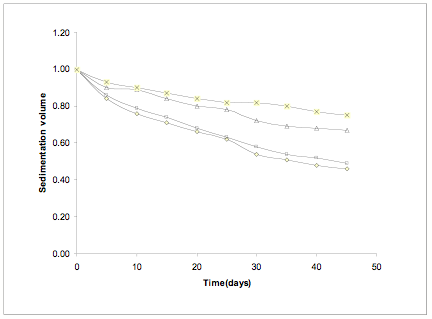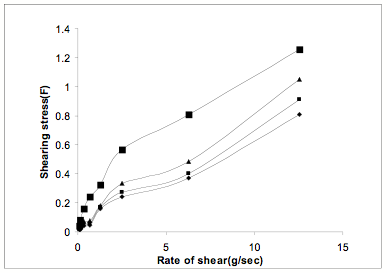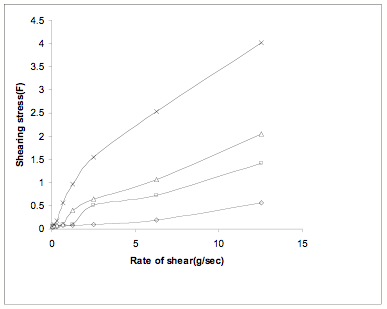Browse through our Medical Journals...
STUDIES ON A NATURAL GUM FOR ITS APPLICATION AS A SUSPENDING AGENT
Panda D S*, Choudhury N S K1, Yedukondalu M2, Si S3 and Gupta R 4
Institute of Pharmacy and Technology, Salipur, Cuttack – 754202, INDIA.
1Department of Pharmacy, SCB Medical College Cuttack, INDIA.
2College of Pharmaceutical Sciences, Mohuda, Berhampur-760001, INDIA.
3School of Pharmacy, ITER, Bhubaneswar, INDIA.
4 Birla Institute of Technology, Mesra, Ranchi, INDIA.
Summary
The gum from tree Moringa oleifera was subjected to preformulation study for evaluation of its safety and suitability for use as suspending agent. Zincoxide suspensions were prepared using (1%, 2%, 3% and 4% w/v) gum of Moringa oleifera and tragacanth. Their sedimentation profile, redispersibility, degree of flocculation and rheolgical behavior were compared. The study revealed that the gum of Moringa oleifera has got properties to be used as a suspending agent and the performance is comparable with that of gum tragacanth.
INTRODUCTION
Gums are widely employed in the pharmacy as thickeners, suspending agents, emulsifying agents, binders and film formers. With the increase in demand for natural gums, it has been necessary to explore the newer sources of gums to meet the industrial demands. India, due to its geographical and environmental positioning has traditionally been a good source for such products among the Asian countries1. There are reports about the successful use of Ocimum gratissimum, Butea monospermama and Leucaena leucocephala seed gum as suspending agent2, 3, 4.
Gum of the tree Moringa oleifera has been reported to have gel forming potential for topical application5. In view of the easy availability of the plant, the exudates from the stem of the tree Moringa oleifera was investigated for its application as suspending agent in pharmaceutical formulations. Moringa oleifera is a small genus of quick growing tree distributed in India. The stem of the tree exudes a gum which is initially white in colour but changes to reddish brown or brownish black on exposure. It is sparingly soluble in water but swells in contact with water giving a highly viscous solution. It is a polyuronide consisting of arabinose, galactose and glucoronic acid in the proportion of 10: 7: 2 moles; rhamnose is present in traces6.
MATERIALS AND METHODS
Zinc oxide (E. Merck, Mumbai, India), Gum of moringa was isolated in the laboratory as per the procedure reported in the research publication5. Gum tragacanth (Loba Chemie, Mumbai), Benzoic acid from SD fine Chemicals Ltd (Mumbai, India). All other materials used were of analytical grade.
EVALUATION OF TOXICITY
The male albino rats of Wistar strain weighing 160-200 gm were divided into different groups comprising of six animals each. The control group received normal saline 25ml/kg i.p. The other groups received 100, 200,400,600,800,1000,2000,3000 and 4000 mg/kg of gum suspension in normal saline orally. The animals were observed continuously for the behavioral changes for the first 4 hours and then observed for mortality if any for 24 hours7.
PREPARATION OF ZINC OXIDE SUSPENSION
Zinc oxide which was sieved through sieve No. 100 and retained on sieve No. 200 was used to yield a 20% suspension in water using tragacanth and Moringa oleifera mucilage in four concentrations (1, 2, 3 and 4% w/v). Zinc oxide was first levigated with glycerin (1:1). Then weighed amount of these suspending agents were added and triturated. The volume was made up with distilled water. The suspensions contained 0.1% w/v benzoic acid as preservative. All the suspensions were deflocculated. To determine the degree of flocculation, flocculated suspensions were made using potassium dihydrogenphosphate(0.004 mol) as flocculating agent.
SEDIMENTATION PARAMETERS
The sedimentation volume were determined by keeping 50 ml of each suspensions in stoppered measuring cylinder and stored undisturbed at room temperature. The separation of clear liquid was noted at intervals of 5 d up to 45 d. The sedimentation volume was calculated using using the formula Vu/Vo, where Vu is the volume of sediment and Vo is the original height of the sample8.
DEGREE OF FLOCCULATION
The degree of flocculation was determined 8, 9 following the equation β= F/Fα, where F is the ultimate sedimentation volume in the flocculated suspension and Fα is the ultimate sedimentation volume in the deflocculated suspension.
REDISPERSION
Fixed volume of each suspension (50 ml) was kept in calibrated tubes which were stored at room temperature for various time intervals of 5d; one tube was removed and shaken vigorously to redistribute the sediment and the presence of deposit if any was recorded.
RHEOLOGICAL STUDY
The rheological behavior of the suspensions prepared with gum tragacanth and gum of Moringa oleifera were studied using Brookfield synchroelectric viscometer, spindle number 1 of low viscosity type with gear speed ranging 0.3 to 0.6 rpm. The dial readings for both up-curve and down curve were recorded and the experiment was repeated for three times. Using these observations, the rate of shear was calculated. The results were recorded and the rheogram were obtained by plotting rate of shear, G/sec vs shearing stress F, Dyne/cm2 (Fig. 3, 4).
RESULTS AND DISCUSSION
Toxicity study of the gum revealed no behavioral changes for first four hours and no mortality was observed even at the dose level 4000mg/kg body weight after 24 hours, indicating the safety of the gum.
The sedimentation volume profile of the suspensions prepared with gum of Moringa oleifera and gum tragacanth are shown in figs. 1 and 2, respectively. The sedimentation volume of the suspensions prepared with gum of Moringa oleifera are comparable with the suspensions prepared using gum tragacanth. The dispersed particles sediment at a faster rate in suspensions containing 1% and 2% w/v of suspending agent and the initial sedimentation during first 20 days are much faster than afterwards. The suspensions prepared with 3% suspending agent shown a constant decline in sedimentation volume up to 20 days whereas, the decline was minimized after 25 days. However the suspensions prepared with 4% suspending agent the change in sedimentation volume was minimum throughout the 45 days of study.
According Martin et al.8 the sedimentation volume provides only a qualitative account of flocculation. The degree of flocculation (β) is more useful parameter, which is the ratio of ultimate sedimentation volume in the flocculated and deflocculated system. A comparison of β values (Table 1) of suspensions prepared with gum of Moringa oleifera and gum tragacanth shows a slight higher value for tragacanth.
Since the suspension produces sediment on storage it must be readily dispersible so as to ensure the uniformity of the dose. If sediment remains even after shaking vigorously for specified time, the system is described as caked. All the suspensions were found to be redispersible irrespective of their concentration.
The rheological behavior of the suspensions prepared with gum of Moringa oleifera and gum tragacanth are given in fig. 3 and 4 respectively. The results reveal that the suspensions are pseudoplastic in their behavior and their viscosity decreases with increase in shear rate, which is an essential property in the formulation of suspension10.
These observations indicate that the suspending properties of Moringa oleifera gum is comparable with that of gum tragacanth.

Fig. 1: Sedimentation profile of suspensions made with different concentrations of gum of Moringa oleifera.
Sedimentation profile of suspensions containing (-?-) 4% w/v, (-?-) 3% w/v, (-?-) 2% w/v and (-♦-) 1% w/v of gum

Fig. 2: Sedimentation profile of suspensions made with different concentrations of gum tragacanth.
Sedimentation profile of suspensions containing (-X-) 4% w/v, (-Δ -) 3% w/v, (-?-) 2% w/v and (-◊-) 1% w/v of gum

Fig. 3: Rheological behavior of suspensions made with different concentrations of gum of Moringa oleifera.
Rheograms of suspensions containing (-?-) 4% w/v, (-?-) 3% w/v, (-?-) 2% w/v and (-♦-) 1% w/v of gum

Fig. 4: Rheological behavior of suspensions made with different concentrations of gum tragacanth.
Rheograms of suspensions containing (-X-) 4% w/v, (-Δ -) 3% w/v, (-?-) 2% w/v and (-◊-) 1% w/v of gum
Table 1: Degree of flocculation (β) of various suspending agents1.
Suspending agent |
Concentration (% w/v) |
Degree of flocculation(β)2 |
Tragacanth |
1 |
2.03 + 0.14 |
2 |
3.00 + 0.28 |
|
3 |
4.40 + 0.38 |
|
4 |
5.13 + 0.17 |
|
Gum of Moringa oleifera |
1 |
1.85 + 0.07 |
2 |
2.7 + 0.09 |
|
3 |
3.82 + 0.32 |
|
4 |
4.91 + 0.18 |
1 Data was recorded after 45 d keeping at room temperature
2 All values are expressed as mean of three observations + SD
REFERENCES
- Whistler, R.L., In; Industrial gums, Academic press, New York, 1973, 2nd Edn., 1.
- Anroop, B., Bhatnagar, S.P., Ghosh, B. and Versha, P., Indian J. Pharm. Sci., 2005, 67(2), 206-209.
- Kale, R.H., Tekade, A.R., Mishra, S.H. and Banarjee, G., Indian J. Nat. Prod., 2006, 22(4), 25-27.
- Verma, P.R.P. and Razdan, B., Indian J. Pharm. Sci., 2003, 65(6), 665-669.
- Panda, D., Si, S. Swain., S, Kanungo, S.K. and Gupta, R.,Indian J. Pharm. Sci., 2006, 68(6), 777-780.
- Wealth of India-Raw Materials, Vol. 2 (1998) Council of Scientific and Industrial Research, New Delhi, p. 429.
- Turner, R.A., The Organisation of screening, In: Screening Methods in Pharmacology, Vol. I, New York and London, Acdemic press; 1965, p. 21.
- Martin, A., In; Physical Pharmacy. 4th Edn., Lippincott William an Wilkins, Baltimore, USA, 2001, p. 480-481.
- Swarbrick, J., Rubino, J.T. and Rubino, O.P., In; Gennaro, A.R., Eds., Vol 1, Lippincott William and Wilkins, Philadelaphia, USA, 2000, p. 318.
- Aulton, M.E., Pharmaceutics The Science of Dosage Form Design. 2nd Edn., Churchill Livingstone, Philadelaphia, USA, 2002, p. 57-58.
First Published October 2007
Click
on these links to visit our Journals:
Psychiatry
On-Line
Dentistry On-Line | Vet
On-Line | Chest Medicine
On-Line
GP
On-Line | Pharmacy
On-Line | Anaesthesia
On-Line | Medicine
On-Line
Family Medical
Practice On-Line
Home • Journals • Search • Rules for Authors • Submit a Paper • Sponsor us
All pages in this site copyright ©Priory Lodge Education Ltd 1994-


